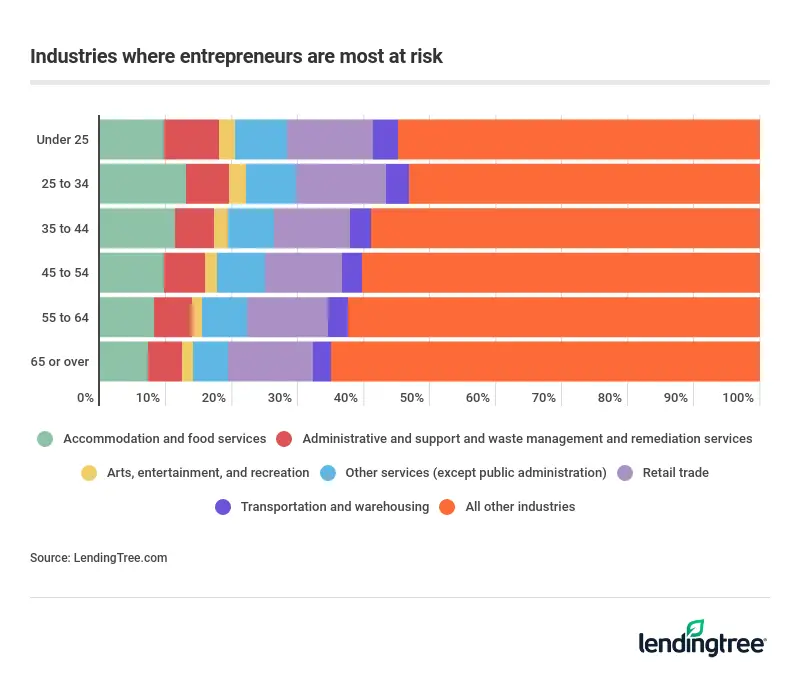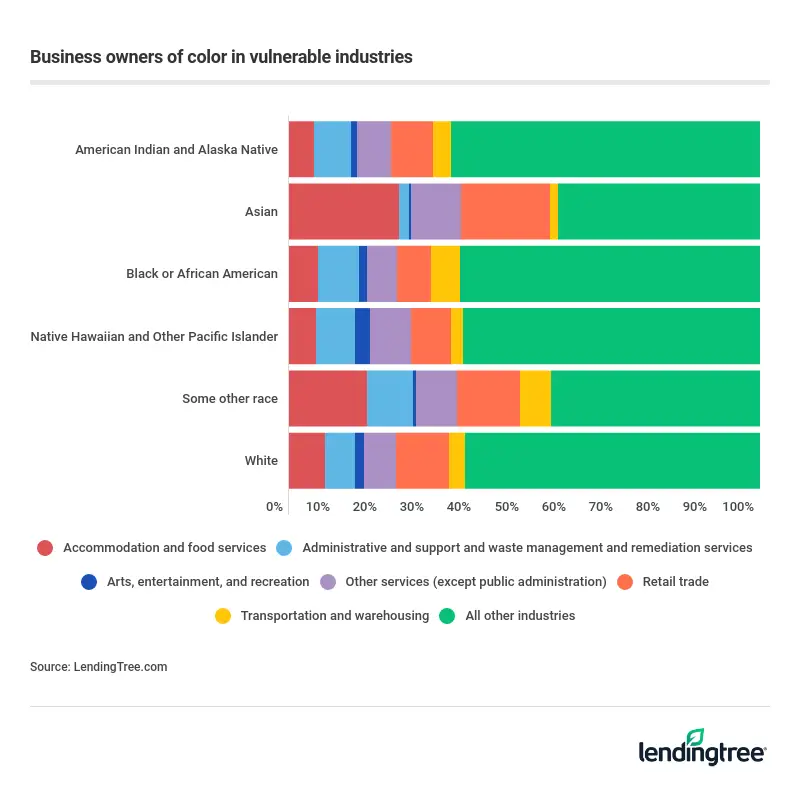Demographics of Business Owners in Hardest-Hit Industries During Coronavirus Pandemic
Young entrepreneurs are disproportionately suffering in the U.S. industries hardest hit by the coronavirus pandemic.
LendingTree researchers found that 45% of businesses with owners younger than 25 years old are in industries with unemployment rates higher than the national average of 13% in May. That figure jumps to nearly 47% for business owners between the ages of 25 and 34.
These hardest-hit sectors make up 40% of all businesses in the U.S. Many of these nonessential businesses closed their doors at some point in recent months to obey government mandates meant to limit the spread of the coronavirus. Most are reopening — as of this writing, about eight in 10 businesses in the U.S. are fully or partially open as local authorities ease restrictions.
Key findings
- Across every industry, the majority of business owners are white and male — 85% of business owners are white and 64% are men. Just 37% of male-owned businesses are found in industries with above average unemployment. Entrepreneurs also tend to be older. Those 55 and older own more than 50% of all businesses.
-
For this study, researchers identified six high-risk industries with unemployment rates surpassing the national average:
- Accommodation and food services
- Administrative and support and waste management and remediation services
- Arts, entertainment and recreation
- Other services (except public administration)
- Retail trade
- Transportation and warehousing
- In addition to young entrepreneurs, Asian business owners are exposed to industries with high unemployment rates — 57% of Asian-owned businesses are in industries with above-average unemployment rates. Just 37% of white-owned businesses operate in the same sectors.
- Business owners who identify as “some other race” on the 2016 Survey of Entrepreneurs are the second most prevalent in industries with high unemployment rates at 56%.
Young business owners operate in high-risk industries
Although the majority of business owners across all industries are 45 years old and older, those who are younger tend to work in industries where unemployment rates are high.

Entrepreneurs between the ages of 25 and 34 are most likely to be in the retail trade sector. About 13.54% of all business owners in the age group operate in this industry. About 11% of business owners between the ages of 35 and 44 are in retail trade, which is also the most popular industry for entrepreneurs in this age demographic.
Retail trade as a sector has an unemployment rate of 16.6%. This time last year, the unemployment rate in retail trade was 4.4%. Business owners younger than 55 years old also make up a large share of the arts, entertainment and recreation industry, which has a 44% unemployment rate.
Asian business owners vulnerable to pandemic effects
White business owners dominate the racial demographics of all industries. But minority groups have a relatively large presence in at-risk industries.
In industries with above-average unemployment rates, Asian business owners are the most prevalent of all minority groups represented. More than half of all Asian-owned businesses operate in vulnerable industries.

How other business owners of color are facing similar risks
Asian business owners are most likely to operate in accommodation and food services, as 23% of Asian-owned ventures are in this sector. Business owners who identify as “some other race” are the next most vulnerable group, as nearly 56% of entrepreneurs in this demographic work in industries with unemployment rates exceeding 13%. Additionally, 36% of black or African-American business owners operate in high-risk sectors.
It should be noted that The Census Bureau does not categorize Hispanic, Latino or Spanish heritage or origin as race. People who identify as Hispanic, Latino or Spanish may be of any race, according to the Census.
Where marginalized communities can find help
Despite operating in hard-hit industries, business owners of color may have been shut out of federal aid programs intended to help small businesses survive the coronavirus pandemic. A report from the U.S. Small Business Administration found that lenders participating in the Paycheck Protection Program (PPP) may not have prioritized underserved markets, including minority groups, as initially instructed.
In response to the criticism, the SBA announced on May 28 that it would set aside $10 billion of PPP funding for Community Development Financial Institutions. CDFIs are lenders designed to serve disadvantaged communities. New legislation signed into law in June is also designed to make it easier for business owners to obtain PPP forgiveness. The Federal Reserve is also preparing to roll out its new Main Street Lending Program.
Methodology
In order to analyze the demographics of vulnerable business owners researchers utilized data from two sources. We used the 2016 Survey of Entrepreneurs to get data on the demographics of business owners and compared that data to the May 2020 U.S. Bureau of Labor Statistics data showing unemployment rate by industry.
Read More
Where Small Business Owners Have the Grimmest Outlook Updated July 22, 2020 While COVID-19 is a national issue, the outbreaks are a local phenomenon — and the…Read More
74% of Small Business Owners Took On Debt to Offset COVID-19 Financial Losses Updated September 29, 2020 74% of small business owners have taken on debt to cope with the financial losses…Read More